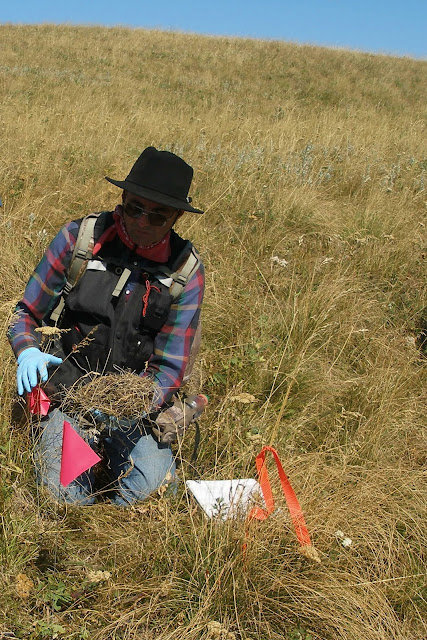"Ecotones" - 8x8 inch digital illustration
Copyright 2011 TwoDressesStudio
All Rights Reserved
Image Credits: Finecrafted Designs, Holliewood Studios
The digital collages posted here (with image credits primarily to Finecrafted Designs) are in response to Ecotone -an event I participated in recently as an artist member of the Field Notes Collective.
The 'weekend' began on Friday evening at the Southern Alberta Art Gallery (SAAG) with two keynote speakers - Ryan Doherty, the curator of the gallery and Dr. Henry Janzen, a scientist at the Canadian Agricultural Research Centre
here in Lethbridge, Alberta. Dr. Janzen is an international expert
in greenhouse gas emissions and mitigation. His speech was compelling,
and began and ended with the awareness of how at that very moment (while
listening to him speak) we would expel a breath, and in it, it
contained a carbon atom that would be released into the atmosphere. A
year later we could pick up a leaf and find that very same carbon atom
within it. He pointed out that until we really 'love' our earth, and
feel as though we are entirely 'connected' to it, we won't be compelled
to embrace it and do whatever necessary to ensure it's survival. We ARE the land.

For the last 60 years, the research centre has been studying the effects of cattle grazing on an area of grassland, nestled in the foothills in front of the Rockie Mountains west of a small town called Stavely. The lead scientist, Dr. Walter Willms presented the research which is defined as "Examine how grazing affects grassland heterogeneity and biodiversity, and its interactions on wildlife, including SARA-listed species, and develop strategies for their recovery and protection.'

The following morning, the Ecotone group (approx. 75 ranchers, artists and scientists) met in Stavely and then boarded buses to travel to the field. The weather was perfect, about 85 F. with a warm wind and not a cloud in the sky. Once there, the lead investigators for the study explained their research in detail and we were taught how they measure the effects of grazing, the 'composition' of the grasslands, each grassland species, soil, ecosystem, watershed, etc. Four separate fields divided into various 'intensities of grazing make up the field site. We broke into subgroups and walked through each field, identifying the native grasses, noxious weeds and non-native species. Each group was lead by two scientists and they taught us how to 'diagnose' the health of the grassland, using different methods of collecting data. There were also fenced areas within the heavy/extremely heavy grazing fields that had been protected for the last 10 years to see if it was possible for these areas to recover from the effects of heavy grazing. Sadly, the answer at this point in time appears to be not. A vivid example of the fragility of the grassland ecosystem.
Above: The large group together listening to the scientists explain the study before breaking out into smaller groups.
A Rancher, 2 Scientists and a Journalist who was recording the Ecotone event as we began by identifying the grassland species of native, non-native and noxious weeds.
Dr. Walter Willms and Dr. Henry Janzen
(the flags you see are marking different grassland species that we identified and studied in each research field)
John, one of the scientists employed by SALT teaching us how they collect and measure 'litter' - the dead plant material that has collected at the base of the grasses - an integral component to measure the overall health of the grasslands and critical to how rain/snow is stored in turn relating to the health of the watershed and ultimately our water.
Here we were measuring how far water travels before it is absorbed (length x time) In the less healthy grasslands, the water travelled significantly farther over a longer period of time, than in the healthy areas.
Once back from the field, we gathered in the Stavely Community Hall for
more presentations addressing several issues of sustainability and
partnerships between the scientists, the ranchers, the artists and the
end consumers of food. This took place after a 100 mile dinner - all
local food...beef, vegetables, berry pies...and of course, Big Rock
Beer.
Ecotones 2 - 8 x 10 inch digital collage
2011 TwoDressesStudio
All Rights Reserved
Image credits - Finecrafted Designs
I'll never look at the grasslands the same way again.













5 comments:
A very interesting and thought provoking post Trudi. Your digitals in this post are stunning. Imagine this is close to your heart....
Really interesting! Your collage is exquisite, thank you for sharing
Oh I wish I could have been part of that. I actually stitch prairie grasses and am deeply in love with the land. What a fascinating experience for you! Thank you for posting. I'm linking this post to my blog tomorrow so my readers can come see. ; )
The images are so beautiful by the way! I have 2 artist friends that make digital collages and I just think they are beautiful!
love you blog,
Monika in Saskatoon
(lived in Calgary for 10 yrs fyi)
I think it is wonderful that you took the time to go for this field trip and demonstration. I really enjoyed hearing about it as well as seeing that fabulous collage. Perfect.
Your work is always beautiful. But knowing the meaning behind your creations...well, that makes it even more beautiful to me.
Post a Comment